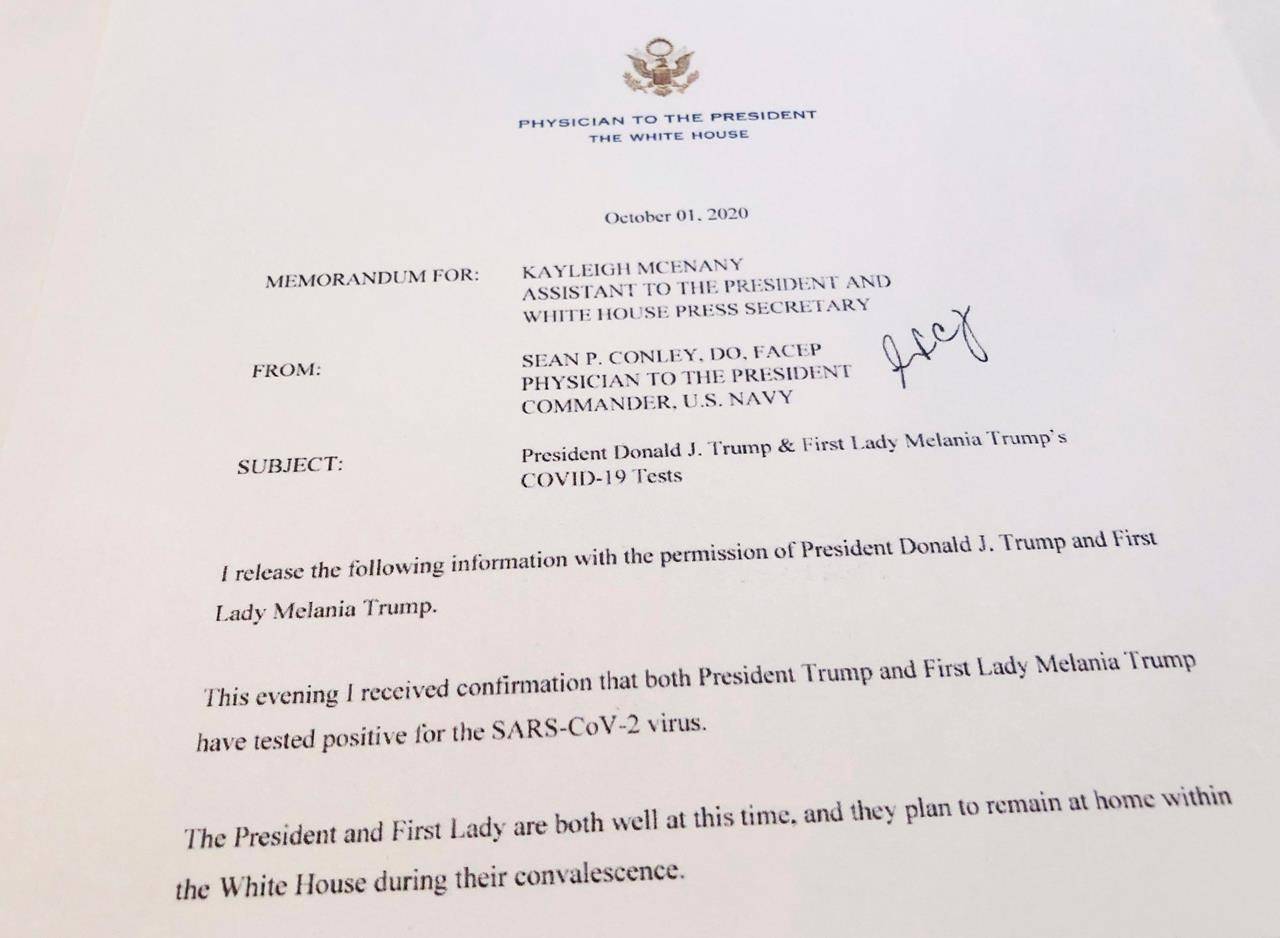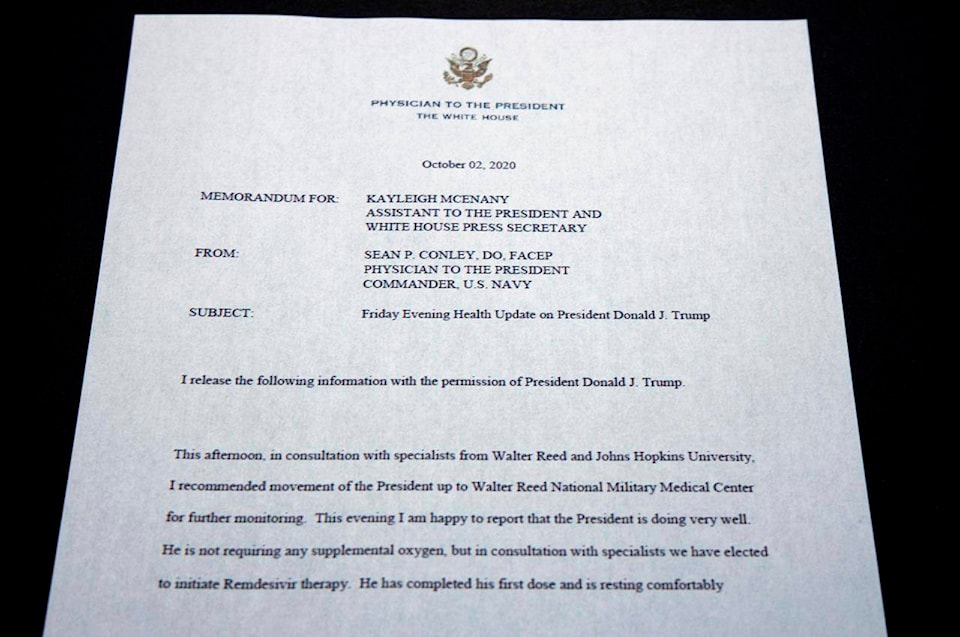BETHESDA, Md. — President Donald Trump’s doctor says he is doing “very well” as he spends the weekend at a military hospital for treatment of COVID-19.
Navy Commander Dr. Sean Conley said Trump has been fever-free for 24 hours as he updated the nation on the president’s condition from the hospital Saturday morning. Trump was admitted Friday after testing positive for the coronavirus.
While Conley said the president is not currently on oxygen, he refused to say whether the president had ever been on oxygen, despite repeated questioning. He said that Trump’s symptoms, including a cough and nasal congestion “are now resolving and improving.”
“He’s in exceptionally good spirits,” said another doctor, Sean Dooley.
ALSO READ: Analysis: We’ll know soon how COVID impacts Trump’s re-election
The decision to have Conley brief reporters marked a change in strategy for an administration that has so far been less than transparent about the virus’ spread inside the White House. It was Bloomberg News – not the White House — that broke the first news that a close aide to Trump had been infected. And aides had declined to share basic health information about the president, including a full accounting of his symptoms, what tests he’s undertaken and the results.
In a memo released shortly before midnight, Conley did report that Trump had been treated at the hospital with remdesivir, an antiviral medication that has been promoted by many in the administration, after taking another experimental drug at the White House. He added that Trump was “doing very well” and is “not requiring any supplemental oxygen.”
The White House said Trump was expected to stay at the hospital for “a few days” and he would continue to work from the hospital’s presidential suite, which is equipped to allow him to keep up his official duties. In addition to accessibility to tests and equipment, the decision was made, at least in part, with the understanding that moving him later, if he took a turn for the worse, could send a worrying signal.
As the White House works to piece together the flurry of new infections, attention is focused in particular on last Saturday’s White House event introducing Trump’s Supreme Court nominee. That day, Trump gathered more than 150 people in the Rose Garden. People mingled, hugged and shook hands — overwhelmingly without masks. There were also several indoor receptions, where Trump’s Supreme Court pick, Judge Amy Coney Barrett, her family, senators and others mingling in the close quarters of the White House, photographs show.
Among those who attended who have now tested positive: former White House counsellor Kellyanne Conway, the president of the University of Notre Dame, and at least two Republican lawmakers — Utah Sen. Mike Lee and North Carolina Sen. Thom Tillis.
The decision for the president to leave the White House for the hospital capped a day of whipsaw events in Washington Friday. The president, who has spent months playing down the threat of the virus, was forced to cancel all campaign events a month before the election as he fought a virus that has killed more than 205,000 Americans and is hitting others in his orbit as well.
Trump walked out of the White House on Friday evening wearing a mask and gave a thumbs-up to reporters but did not speak before boarding Marine One. Members of the aircrew, Secret Service agents and White House staff wore face coverings to protect themselves from the president onboard the helicopter.
In a video taped before leaving for Walter Reed, Trump said, “I think I’m doing very well, but we’re going to make sure that things work out.” He remained fully president, all authority intact.
“Going welI, I think! Thank you to all. LOVE!!!” he wrote in his first tweet from the hospital Friday night.
Trump first revealed that he had tested positive in a tweet just before 1 a.m. Friday — hours after he returned from a Thursday afternoon political fundraiser in New Jersey. He had gone ahead to the event, saying nothing to the crowd, even though he knew he had been exposed to an aide with the disease that has infected millions in America and killed more than 1 million people worldwide.
First lady Melania Trump also tested positive and has said she has mild symptoms. She is believed to be isolating at the White House.
Also testing positive: Trump’s campaign manager, Bill Stepien, who joined Trump at Tuesday’s first presidential debate, as well as former New Jersey Gov. Chris Christie, who helped him with debate prep. On Saturday, Sen. Ron Johnson of Wisconsin became the third Senate Republican to publicly confirm testing positive in the current spate of infections, although Johnson was not at last week’s Rose Garden event.
Trump’s diagnosis came during an already turbulent period in Washington and around the world, with the U.S. gripped in a heated presidential election and the pandemic taking a heavy human and economic toll. Trump’s immediate campaign events were all cancelled, and his next debate with Democrat Joe Biden, scheduled for Oct. 15, is now in question.
Trump has been trying all year — and as recently as Wednesday — to convince the American public that the worst of the pandemic is past, and he has consistently played down concerns about being personally vulnerable. He has mostly refused to abide by basic public health guidelines — including those issued by his own administration — such as wearing face coverings in public and practicing social distancing. Until he tested positive, he continued to hold campaign rallies that drew thousands of often maskless supporters.
“I felt no vulnerability whatsoever,” he told reporters back in May. With the election coming up in a month, he is urging states and cities to “reopen” and reduce or eliminate shutdown rules despite continuing virus outbreaks.
The White House tried to maintain an atmosphere of business-as-usual on Friday.
“President Trump remains in good spirts, has mild symptoms, and has been working throughout the day,” said press secretary Kayleigh McEnany. “Out of an abundance of caution, and at the recommendation of his physician and medical experts, the president will be working from the presidential offices at Walter Reed for the next few days.”
Trump received a dose of an experimental antibody combination by Regeneron that is in clinical trials, according to Conley, as well as remdesivir therapy, the antiviral medication.
“He has completed his first dose and is resting comfortably,” Conley wrote in his late Friday memo.
The first lady, who is 50, has a “mild cough and headache,” Conley reported, and the remainder of the first family, including the Trumps’ son Barron, who lives at the White House, has tested negative.
The first lady, who is 50, has a “mild cough and headache,” Conley reported, and the remainder of the first family, including the Trumps’ son Barron, who lives at the White House, tested negative.
Trump is 74 years old and clinically obese, putting him at higher risk of serious complications from a virus that has infected more than 7 million people nationwide.
Both Biden and his running mate Kamala Harris have tested negative, their campaign said. Vice-President Mike Pence tested negative for the virus Friday morning and “remains in good health,” his spokesman said. Pence was to resume his campaign schedule after his test.
Barrett, who was with Trump and many others on Saturday and has been on a Capitol Hill meeting with lawmakers, also tested negative, the White House said. It was confirmed that she had a mild case of COVID earlier this year and has now recovered.
Many White House and senior administration officials were undergoing tests,, but the full scale of the outbreak around the president may not be known for some time as it can take days for an infection to be detectable by a test. Officials with the White House Medical Unit were tracing the president’s contacts.
Trump’s handling of the pandemic has already been a flashpoint in his race against Biden, who spent much of the summer off the campaign trail and at his home in Delaware, citing concern about the virus. Biden has since resumed a more active campaign schedule, but with small, socially distanced crowds. He also regularly wears a mask in public, something Trump mocked him for at Tuesday night’s debate.
“I don’t wear masks like him,” Trump said. “Every time you see him, he’s got a mask. He could be speaking 200 feet away from me, and he shows up with the biggest mask I’ve ever seen.”

